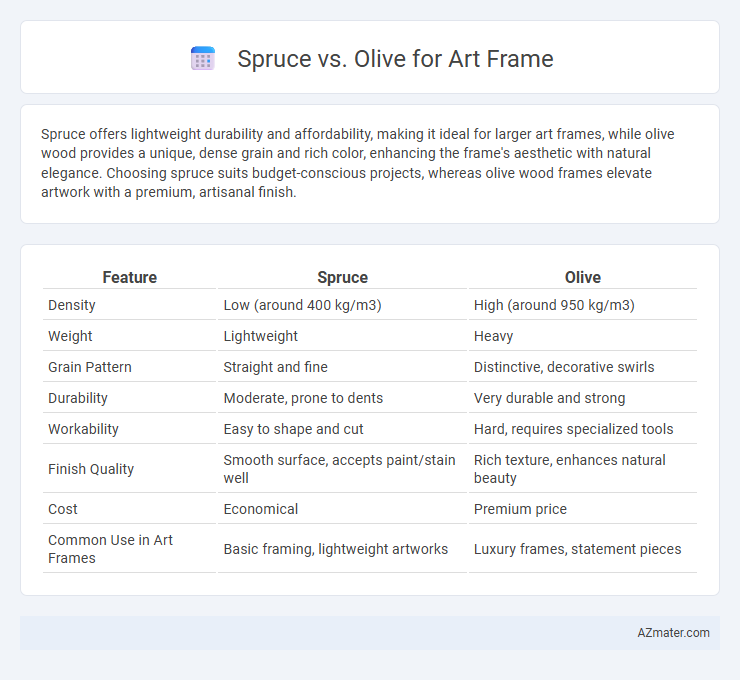Spruce offers lightweight durability and affordability, making it ideal for larger art frames, while olive wood provides a unique, dense grain and rich color, enhancing the frame's aesthetic with natural elegance. Choosing spruce suits budget-conscious projects, whereas olive wood frames elevate artwork with a premium, artisanal finish.
Table of Comparison
| Feature | Spruce | Olive |
|---|---|---|
| Density | Low (around 400 kg/m3) | High (around 950 kg/m3) |
| Weight | Lightweight | Heavy |
| Grain Pattern | Straight and fine | Distinctive, decorative swirls |
| Durability | Moderate, prone to dents | Very durable and strong |
| Workability | Easy to shape and cut | Hard, requires specialized tools |
| Finish Quality | Smooth surface, accepts paint/stain well | Rich texture, enhances natural beauty |
| Cost | Economical | Premium price |
| Common Use in Art Frames | Basic framing, lightweight artworks | Luxury frames, statement pieces |
Introduction: Why Frame Wood Choice Matters
Selecting the right wood for an art frame significantly influences durability, aesthetics, and preservation of the artwork. Spruce offers a lightweight, pale tone with fine grain, ideal for minimalist or modern designs, while olive wood provides a dense, richly textured surface with natural color variation, enhancing traditional or rustic art pieces. Considering factors like wood hardness, grain pattern, and moisture resistance ensures the chosen frame complements and protects the artwork effectively over time.
Overview of Spruce Wood for Art Frames
Spruce wood is a popular choice for art frames due to its lightweight nature and smooth, fine grain that allows for detailed finishes and painting. Its pale color provides a neutral backdrop that enhances the visibility of artwork without overwhelming the piece. Spruce also offers good strength and stability, making it suitable for both contemporary and classic frame designs.
Overview of Olive Wood for Art Frames
Olive wood for art frames is prized for its rich, warm tones and distinctive grain patterns that add a natural elegance to artworks. Its dense, durable nature provides a sturdy structure, ensuring long-lasting protection and a refined aesthetic. Compared to spruce, olive wood offers greater hardness and visual appeal, making it a premium choice for high-quality frames.
Durability: Spruce vs Olive
Olive wood offers superior durability for art frames due to its dense grain and natural resistance to scratches and wear, making it ideal for preserving artwork over time. Spruce, while lightweight and easy to work with, lacks the hardness and long-lasting resilience of olive wood, resulting in frames that may be more prone to dents and damage. For frames intended to withstand environmental stress and maintain structural integrity, olive wood provides a more robust, lasting option compared to spruce.
Aesthetic Differences: Grain, Color, and Texture
Spruce art frames exhibit a lighter, more uniform grain with fine texture, lending a clean and minimalist aesthetic ideal for modern or Scandinavian-style interiors. Olive wood frames feature a distinctive, swirling grain pattern with rich, warm hues of golden brown and intricate textures, creating a striking, rustic appearance that enhances traditional or eclectic artworks. The contrasting color tones and grain structures between spruce and olive make them suitable for different artistic presentations and interior design preferences.
Weight and Handling: Comparing Spruce and Olive
Spruce wood is significantly lighter than olive wood, making art frames easier to handle and transport without compromising strength. Olive wood, while heavier, offers a denser texture that provides exceptional durability and a luxurious finish. Choosing spruce frames benefits projects requiring lightweight, versatile framing, whereas olive frames suit those prioritizing robustness and aesthetic appeal.
Sustainability and Eco-Friendliness
Spruce is a fast-growing softwood that offers a renewable and carbon-efficient option for art frames due to its high sequestration rate and minimal processing requirements. Olive wood, while denser and slower-growing, is sourced from pruned branches and discarded trees, making it a sustainable choice that reduces waste and promotes responsible forestry. Both materials contribute to eco-friendly framing by reducing deforestation impact, with spruce excelling in renewability and olive wood in waste minimization and durability.
Cost Comparison for Spruce and Olive Frames
Spruce frames are generally more cost-effective than olive wood frames due to the abundance and faster growth rate of spruce trees, which lowers material and production expenses. Olive wood, valued for its unique grain patterns and durability, commands a higher price point that reflects its rarity and longer harvesting period. Choosing spruce offers budget-friendly options for art framing without sacrificing structural quality, while olive wood frames serve as premium, artisanal pieces that elevate artwork through distinctive aesthetic appeal.
Best Uses: When to Choose Spruce or Olive
Spruce frames are ideal for lightweight and rustic art pieces, offering a soft texture that enhances natural and minimalist designs, making them perfect for watercolor paintings and botanical prints. Olive wood frames, known for their rich grain and durability, suit more formal or traditional artworks, such as oil paintings and detailed portraits, providing a warm, sophisticated finish. Choose spruce when prioritizing cost-effectiveness and versatility in casual settings, while olive frames excel when seeking elegance and longevity in high-end or heritage art displays.
Conclusion: Which Wood is Best for Your Artwork?
Spruce offers lightweight durability and a smooth grain, making it ideal for minimalist or modern art frames where subtlety is key. Olive wood provides a unique, richly textured appearance with natural color variations, perfect for enhancing traditional or rustic artwork with added warmth. Choosing between spruce and olive ultimately depends on the artwork's style and desired aesthetic impact, balancing frame weight and visual prominence.

Infographic: Spruce vs Olive for Art Frame
 azmater.com
azmater.com